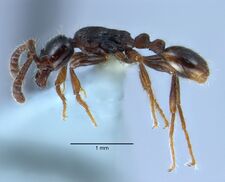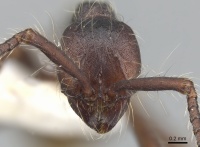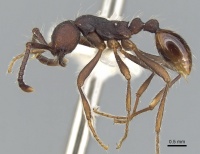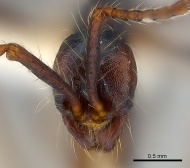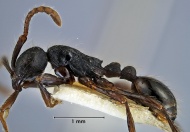Key to Aenictus pachyerus group species
The following worker key is based on Jaitrong, W.; Wiwatwitaya, D. 2013. Two new species of the Aenictus pachycerus species group (Hymenoptera: Formicidae: Aenictinae) from Southeast Asia. Raffles Bulletin of Zoology. 61:97-102.
This key does not include two species described after 2013, Aenictus sirenicus and Aenictus kadalarensis.
You might be interested in
- Aenictus species groups (diagnoses)
- Key to Aenictus species groups
- The Aenictus genus page.
1
- Head entirely smooth and shiny; dorsum of mesosoma entirely smooth and shiny . . . . . 2
- Head entirely sculptured or partly smooth and shiny; dorsum of mesosoma entirely sculptured or partly smooth and shiny . . . . . 4
2
return to couplet #1
- Promesonotum in profile with clearly convex dorsal outline; propodeum lower than promesonotum; body yellowish brown (Philippines) . . . . . Aenictus powersi
- Mesosoma dorsally flat or feebly convex; body reddish brown . . . . . 3
3
return to couplet #2
- Smaller species (HW 0.63–0.65 mm); propodeum in profile with feebly convex dorsal outline; longest pronotal hair 0.25–0.28 mm (Philippines) . . . . . Aenictus carolianus
- Larger species (HW 0.75–0.78 mm); propodeum in profile with straight dorsal outline; longest pronotal hair ca. 0.15 mm (Philippines) . . . . . Aenictus reyesi
4
return to couplet #1
- First gastral tergite superficially shagreened (Vietnam, Laos, and Thailand) . . . . . Aenictus paradentatus
- First gastral tergite smooth and shiny . . . . . 5
5
return to couplet #4
- Side of head partly smooth and shiny; dorsal face of pronotum partly shiny . . . . . 6
- Side of head entirely sculpturate (punctate or reticulate); dorsal face of pronotum entirely sculptured and opaque . . . . . 7
6
return to couplet #5
- Area just outside parafrontal ridge shagreened; vertex reticulate, with sparse standing hairs (less than 12); postpetiole almost as long as petiole (Sulawesi) . . . . . Aenictus sulawesiensis
- Area just outside parafrontal ridge with several irregular longitudinal rugulae; vertex finely punctate; vertex with denser standing hairs (more than 15); petiole distinctly longer than petiole (Java) . . . . . undescribed species - A. sp. 84 of WJT
7
return to couplet #5
- Propodeal junction in profile with protruding edge that is longer than maximum length of propodeal spiracle, very thin, acute, and far overhanging declivitous face; antennal scape longer (SI 143–152) (Malay Peninsula, Sumatra, Borneo and Java) . . . . . Aenictus dentatus
- Edge of propodeal junction not longer than maximum spiracle width and not overhanging the declivitous face; antennal scape shorter (SI 110 or less than) . . . . . 8
8
return to couplet #7
- Lateral face of pronotum partly smooth and shiny or superficially shagreened with smooth and shiny interspaces; area just outside parafrontal ridge with 3–5 irregular longitudinal rugulae (Borneo) . . . . . Aenictus kutai
- Lateral face of pronotum entirely sculpturate and opaque; area just outside parafrontal ridge finely punctate . . . . . 9
9
return to couplet #8
- Apical half of femora superficially reticulate with smooth and shiny bottoms; smaller species (TL 3.5–3.60 mm; HW 0.65–0.68 mm) (Philippines, Sulawesi and Australia) . . . . . Aenictus nesiotis
- Entire femora finely punctate; larger species (TL 3.65–5.10 mm; HW 0.70–0.98 mm) . . . . . 10
10
return to couplet #9
- Petiole sessile; subpetiolar process developed, triangular; ventral outline of postpetiole almost straight or weakly convex; larger species (TL 4.85–5.10 mm; HW 0.90–0.98 mm) (S. China and Vietnam) . . . . . Aenictus bobaiensis
- Petiole subsessile; subpetiolar process low, its ventral outline convex; ventral outline of postpetiole feebly concave; smaller species (TL 3.65–4.20 mm; HW 0.70–0.80 mm) (Malay Peninsula, Borneo, and Buru Island) . . . . . Aenictus levior



